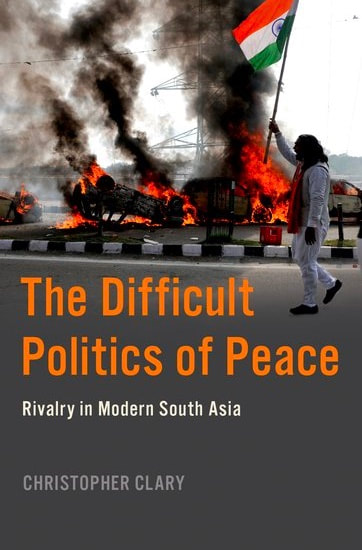Available for order at Amazon or Oxford University Press.
Why have India and Pakistan fought four wars since 1947? Why have both rivals continued to devote enormous resources to their military competition even as they faced other pressing challenges? In The Difficult Politics of Peace, I show how rivalries transform the politics of rival states in ways that favor continued confrontation and complicate attempts at peace-building. Only national leaders who manage to consolidate foreign policy authority can respond to strategic incentives for cooperation rather than remain trapped in conflict. Leaders that fail to control competing domestic power centers instead must contend with insubordination, spoiling, and sabotage when attempting rapprochement with foreign adversaries.
The book traces the seven-decade-plus India-Pakistan rivalry as it has navigated periods of crisis and war and as leaders have tried and failed at rapprochement and peace-building. I bring to bear new evidence from recently declassified documents and policymaker interviews to understand why Pakistan fought losing wars with India over Kashmir in 1965 and 1999 and over East Pakistan in 1971. The book examines the failures of summit diplomacy at Tashkent, Simla, Lahore, and Agra and the ups and downs of backchannel diplomacy in the 2000s. This account shows how Pakistan’s dangerous civil-military relationship and India’s fractious coalition politics have often stymied leaders that attempted to build a more durable peace between the South Asian rivals. In so doing, I encourage a revised understanding of the causes of war and peace that brings difficult and sometimes dangerous domestic politics to the forefront.
Why have India and Pakistan fought four wars since 1947? Why have both rivals continued to devote enormous resources to their military competition even as they faced other pressing challenges? In The Difficult Politics of Peace, I show how rivalries transform the politics of rival states in ways that favor continued confrontation and complicate attempts at peace-building. Only national leaders who manage to consolidate foreign policy authority can respond to strategic incentives for cooperation rather than remain trapped in conflict. Leaders that fail to control competing domestic power centers instead must contend with insubordination, spoiling, and sabotage when attempting rapprochement with foreign adversaries.
The book traces the seven-decade-plus India-Pakistan rivalry as it has navigated periods of crisis and war and as leaders have tried and failed at rapprochement and peace-building. I bring to bear new evidence from recently declassified documents and policymaker interviews to understand why Pakistan fought losing wars with India over Kashmir in 1965 and 1999 and over East Pakistan in 1971. The book examines the failures of summit diplomacy at Tashkent, Simla, Lahore, and Agra and the ups and downs of backchannel diplomacy in the 2000s. This account shows how Pakistan’s dangerous civil-military relationship and India’s fractious coalition politics have often stymied leaders that attempted to build a more durable peace between the South Asian rivals. In so doing, I encourage a revised understanding of the causes of war and peace that brings difficult and sometimes dangerous domestic politics to the forefront.
